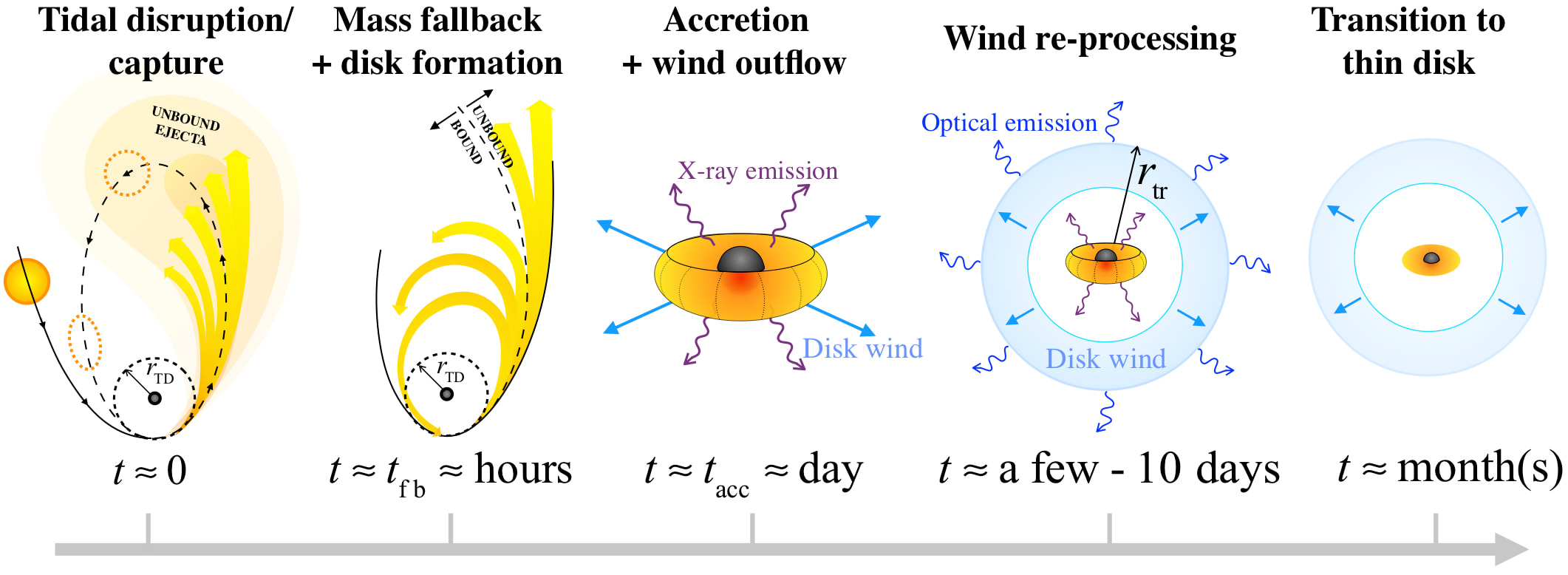Hydrodynamics of Tidal disruption events & Stellar collisions
An inevitable consequence of the presence of black holes in dense star clusters is the tidal disruption of stars during close encounters with the black holes (Kremer et al. 2019d. When a main sequence star is tidal disrupted by a stellar-mass black hole, a thick torus forms and the subsequent evolution depends on the uncertain details of super-Eddington accretion. If the majority of disk mass accretes onto the black hole and if the release of accretion energy is highly efficient (i.e., if a jet is launched), ultra-long gamma ray bursts may be powered (Perets et al. 2016). On the other hand, in the widely accepted adiabatic inflow-outflow model of e.g., Blandford & Begelman 1999, the mass inflow of a super-Eddington disk onto a black hole is non-conservative and only a small fraction of the mass supplied is actually accreted, with the remaining disk mass blown away in a wind. In this case, the energy generated by accretion in the inner disk (predominately X-rays) will be reprocessed by this wind and released as optical/UV emission with rise times (set by the viscous timescale of the disk) of order days (Kremer et al. 2019d; see Figure 1). The peak optical luminosities and rise time are consistent with those of the emerging class of fast blue optical transients (FBOTs; e.g., Drout et al. 2014; Margutti et al. 2019). Current/future all-sky surveys like ZTF and Rubin will confirm the possible connection with FBOTs or other observed transients.
Figure 1: Adapted from Kremer et al. (2021a). Schematic of a stellar-mass black hole TDE including disk formation and evolution. From left to right: (1) Tidal disruption of the star, allowing for a possible initial partial disruption that unbinds a small fraction of material while the star is tidally captured, (2) Fallback of bound material to pericenter, (3) Rise time for X-ray emission (roughly 10^44 erg/s) through viscous accretion onto the black hole, (4) Reprocessing of the X-ray emission by disk wind at the trapping radius leads to bright optical emission (10^41-10^44 erg/s), (5) Transition to thin disk and prompt drop in mass transfer rate and luminosity.
Simulations of the hydrodynamics of close encounters between black holes and stars are critical to elucidate the various possible outcomes and their details. In contrast to the supermassive black hole TDE regime (for recent reviews see Stone et al. 2019, Gezari et al. 2021), the hydrodynamics of TDEs in the stellar-mass black hole regime have been relatively unexplored, with a few exceptions that focused on distant encounters near the classical tidal disruption radius. The direct collision regime where the pericenter distance is comparable to or less than the stellar radius has not been explored at all in this context. In Kremer et al. 2022, we investigated this topic using the smoothed particle hydrodynamics (SPH) code StarSmasher which was designed specifically to compute stellar collisions and tidal interactions. I include below videos of simulations of a few representative encounter types.
Figure 2: A head-on collision between a 2 solar mass star and a 10 solar mass black hole. The star is destroyed completely through the black hole encounter. After the encounter, roughly half of the disrupted material is unbound from the system and half remains bound to the black hole. In response to this mass loss, the black hole receives an impulsive kick of roughly 100 km/s. In general, kick of this order are likely sufficient to eject the black hole from their host cluster.
Figure 3: A 5 solar mass star encountering a 10 solar mass black hole with pericenter distance equal to tidal disruption radius of star. The star is partially disrupted on first passage and tidally captured by the black hole. The partially disrupted remnant returns to pericenter for a second time roughly 4 days after the first passage and undergoes 4 total passages before ultimately being disrupted completely by the black hole.
Figure 4: A 0.5 solar mass star (modeled as an n=1.5 polytrope) encountering a 10 solar mass black hole with pericenter distance equal to the classic tidal disruption radius of the star. The star is partially disrupted on first passage and receives an impulsive kick from asymmetric mass loss at pericenter. The roughly 0.2 solar mass partially-disrupted stellar remnant has final velocity of roughly 260 km/s and would likely be ejected from its host cluster.
